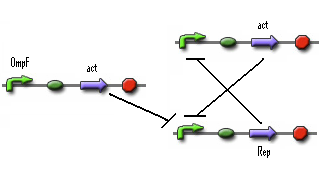Team:KULeuven/Project/Memory
From 2008.igem.org
Contents |
Memory
BioBricks
Components
[http://partsregistry.org/Part:BBa_C0052 BBa_C0052] is the cI repressor from phage 434, modified with an LVA-tag. It is placed under control of [http://partsregistry.org/Part:BBa_R0053 BBa_R0053], the phage P22 cII regulated promoter. [http://partsregistry.org/Part:BBa_C0053 BBa_C0053] codes for this cII P22 repressor protein and is placed under control of a standardised right cI 434 promoter [http://partsregistry.org/Part:BBa_R1052 BBa_R1052]. A third subdivision consists of the [http://partsregistry.org/Part:BBa_C0052 BBa_C0052] cI repressor from phage 434 under control of the TetR promoter ([http://partsregistry.org/Part:BBa_R0040 BBa_R0040]). In this instance however, the cI 434 protein is not LVA-tagged. The fourth and last subdivision is an antisense LuxI mRNA (encoded by [http://partsregistry.org/Part:BBa_K145013 BBa_K145013]) once again under control of the standardised right cI 434 promoter [http://partsregistry.org/Part:BBa_R1052 BBa_R1052].
Action
Now for how this memory device works. When there is no signal from the input device (through [http://partsregistry.org/Part:BBa_R0040 BBa_R0040], the TetR promoter), and there has never been one, the P22 c2 repressor will gain control over the system. P22 c2 and not 434 cI controls this OFF state because it has a lower Kd, a stronger promoter ([http://partsregistry.org/Part:BBa_R1052 BBa_R1052] vs [http://partsregistry.org/Part:BBa_R0053 BBa_R0053]) for its transcription and a more efficient RBS for its translation ([http://partsregistry.org/Part:BBa_B0031 BBa_B0031] vs [http://partsregistry.org/Part:BBa_B0033 BBa_B0033]) than cI 434. This means that the synthesis of cI 434 ([http://partsregistry.org/Part:BBa_C0052 BBa_C0052], LVA-tagged) mRNA will be repressed from the c2 P22 regulated promoter.
no 434 cI repressor is made. This means that there is no repression of [http://partsregistry.org/Part:BBa_I12006 BBa_I12006], the right 434 cI promoter. As a consequence of this, [http://partsregistry.org/Part:BBa_C0053 BBa_C0053], the phage 22 cII repressor is made, repressing [http://partsregistry.org/Part:BBa_R0053 BBa_R0053], the cII p22 regulated promoter. As said, [http://partsregistry.org/Part:BBa_I12006 BBa_I12006] is not repressed, and antisense LuxI ([http://partsregistry.org/Part:BBa_K145013 BBa_K145013]) makes sure that no LuxI is transcribed, thereby preventing HSL production.
From the moment an input signal emerges, the 434 cI repressor is made, repressing transcription of phage 22 cII repressor. This turns the phage 22 promoter on, resulting in further production of phage 434 cI repressor. Antisense LuxI production ceases, and LuxI begins producing HSL.
From now on, phage 434 cI repressor accumulates and phage 22 cII inhibitor concentrations quickly drop to zero. This is nicely pictured on the modeling page of the memory system.
 "
"




 Input
Input Output
Output Filter
Filter InverTimer
InverTimer Reset
Reset Cell Death
Cell Death Memory
Memory